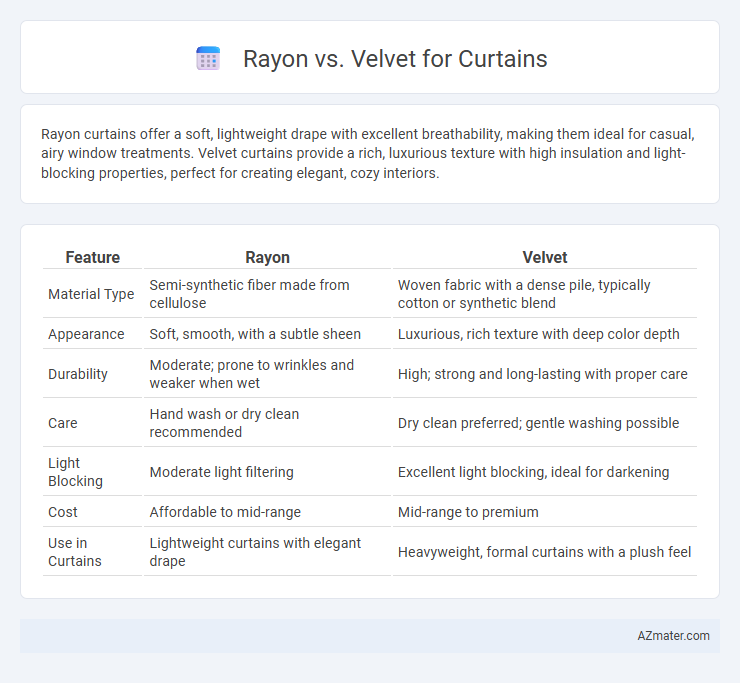Rayon curtains offer a soft, lightweight drape with excellent breathability, making them ideal for casual, airy window treatments. Velvet curtains provide a rich, luxurious texture with high insulation and light-blocking properties, perfect for creating elegant, cozy interiors.
Table of Comparison
| Feature | Rayon | Velvet |
|---|---|---|
| Material Type | Semi-synthetic fiber made from cellulose | Woven fabric with a dense pile, typically cotton or synthetic blend |
| Appearance | Soft, smooth, with a subtle sheen | Luxurious, rich texture with deep color depth |
| Durability | Moderate; prone to wrinkles and weaker when wet | High; strong and long-lasting with proper care |
| Care | Hand wash or dry clean recommended | Dry clean preferred; gentle washing possible |
| Light Blocking | Moderate light filtering | Excellent light blocking, ideal for darkening |
| Cost | Affordable to mid-range | Mid-range to premium |
| Use in Curtains | Lightweight curtains with elegant drape | Heavyweight, formal curtains with a plush feel |
Introduction to Rayon and Velvet Curtains
Rayon curtains offer a lightweight and breathable fabric option, prized for their smooth texture and ability to mimic the appearance of silk at a lower cost. Velvet curtains provide a luxurious, heavy drape with a dense pile that adds richness and excellent insulation properties to any room. Choosing between rayon and velvet depends on desired aesthetics, durability, and light-blocking capabilities for interior window treatments.
Key Differences Between Rayon and Velvet
Rayon curtains offer a lightweight, breathable fabric with a smooth texture that mimics natural fibers, making them ideal for casual or modern interiors. Velvet curtains, made from densely woven fibers such as silk or synthetic materials, provide a luxurious, heavy texture that enhances insulation and blocks light effectively, perfect for formal or traditional settings. The key differences lie in their texture, thickness, insulation properties, and aesthetic appeal, with rayon prioritizing softness and breathability while velvet emphasizes opulence and durability.
Texture and Visual Appeal Comparison
Rayon curtains offer a smooth, silky texture that drapes elegantly, enhancing light diffusion and adding a subtle sheen to the room. Velvet curtains boast a rich, plush texture with a dense pile, creating a luxurious, opulent appearance that absorbs light for a cozy ambiance. The visual appeal of rayon suits modern, lightweight designs, while velvet excels in traditional or formal settings requiring depth and warmth.
Durability and Longevity
Rayon curtains offer moderate durability, but their strength can weaken over time when exposed to direct sunlight or frequent washing, making them less ideal for long-term use. Velvet curtains are highly durable due to their dense weave and heavy fabric, providing superior longevity and resistance to wear and fading. Velvet is especially suitable for maintaining its luxurious appearance in high-traffic or sun-exposed areas.
Maintenance and Cleaning Requirements
Rayon curtains require gentle handling during cleaning due to their delicate fibers, often necessitating dry cleaning to prevent shrinkage and damage. Velvet curtains, typically thicker and more durable, can be vacuumed regularly to remove dust and spot cleaned, but they also usually require professional dry cleaning to maintain their rich texture. Both fabrics demand careful maintenance to preserve their appearance, with velvet benefiting from periodic brushing to avoid matting and rayon needing avoidance of harsh detergents.
Light Filtration and Privacy
Rayon curtains provide moderate light filtration, offering a soft, diffused glow that enhances privacy without completely blocking sunlight. Velvet curtains excel in light blockage, creating near-total darkness and maximum privacy due to their dense fabric and thick weave. For spaces requiring strong light control and privacy, velvet is the superior choice, while rayon suits rooms needing gentle illumination with moderate privacy.
Cost Comparison: Rayon vs Velvet
Rayon curtains generally cost less than velvet curtains due to rayon's synthetic fiber production being more affordable and widely available. Velvet curtains are pricier because of their dense pile weave and the use of natural fibers like silk or cotton blends, which increase manufacturing costs. Choosing rayon offers budget-friendly options without sacrificing durability, while velvet provides a luxurious appearance at a higher price point.
Environmental Impact of Each Fabric
Rayon curtains, derived from cellulose fibers, often involve chemical-intensive manufacturing processes that can contribute to water pollution and higher energy consumption. Velvet made from synthetic fibers like polyester typically relies on petroleum-based resources, resulting in a larger carbon footprint and longer decomposition times. Choosing sustainably sourced or recycled materials for each fabric type can significantly reduce their environmental impact in curtain production.
Best Decor Styles for Rayon and Velvet Curtains
Rayon curtains complement contemporary and modern decor styles by offering a smooth, lustrous finish that enhances minimalist and sleek interiors. Velvet curtains are ideal for traditional, luxurious, and vintage decor, providing a rich texture and depth that adds warmth and elegance to formal living rooms and classic settings. Both fabrics offer distinct aesthetic appeals, with rayon suited for light, airy spaces and velvet perfect for creating plush, opulent atmospheres.
Final Verdict: Choosing the Right Fabric for Your Curtains
Rayon offers a lightweight, breathable texture ideal for casual, flowing curtains that allow natural light while maintaining soft drape. Velvet provides a luxurious, heavy-weight option excellent for blocking light, enhancing insulation, and adding a rich, elegant aesthetic to any room. For a balance between affordability and appearance, rayon suits budget-conscious buyers, whereas velvet is perfect for those prioritizing opulence and room darkening.

Infographic: Rayon vs Velvet for Curtain
 azmater.com
azmater.com